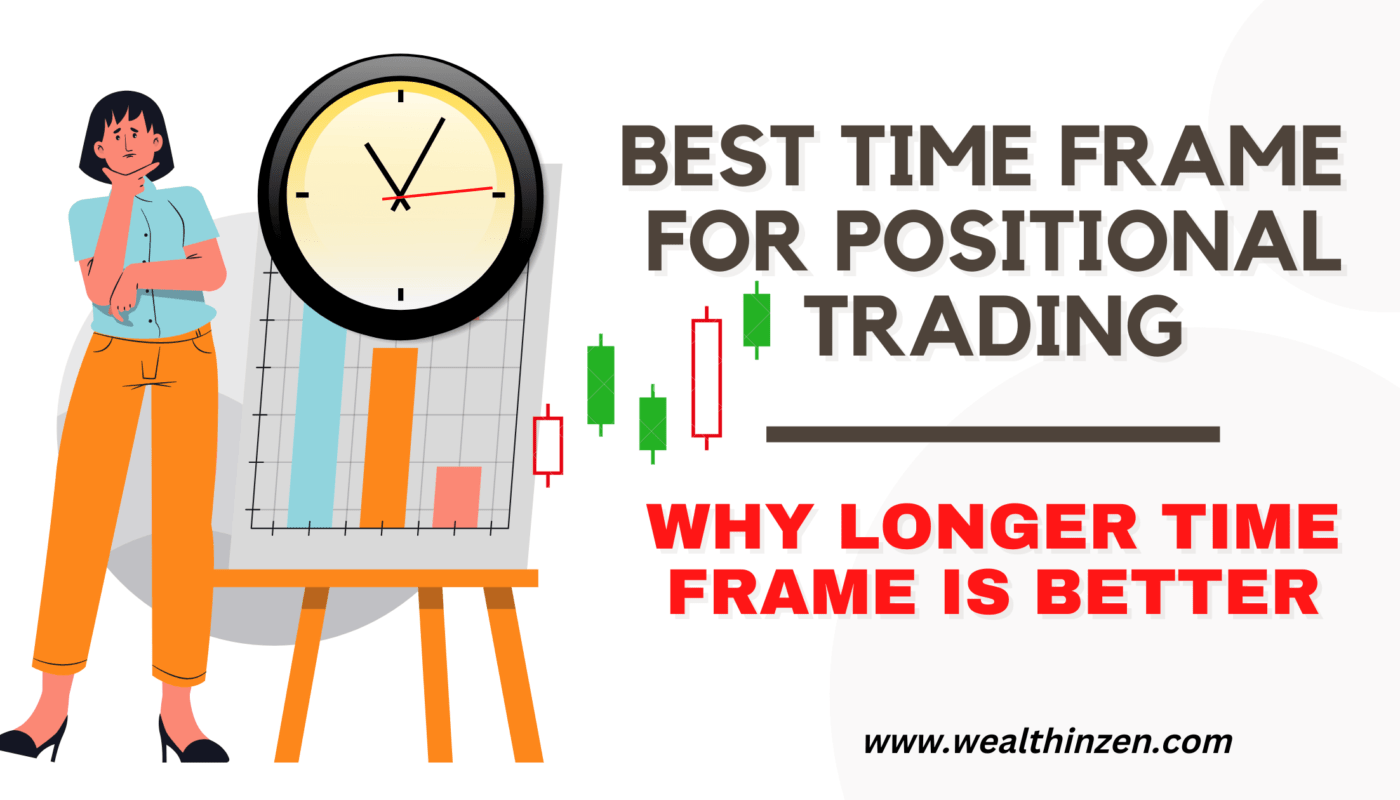The question that every trader, particularly the beginners, often have is, “Which time frame should I trade?” Most traders, (including me at the beginning) start as a day trader. This is because, You-tube is full of tutorials that teach “how to do day trading for a living”. Unfortunately, there are very few people out there to teach about long term investing / positional trading and even for them the viewers are lesser in comparison. So, here also it is a kind of supply demand concept.
But after day trading a while I came to a conclusion – Why should I live a life by Day Trading when I am already successful in my career I had chosen?
My purpose of coming to the stock market is to build wealth with less tension. But, I later realized how difficult day trading is and almost every time, I was unable to control things like random news flow, high volatility, Stop Loss hunting by the institutions, time getting exhausted etc., in day trading. (For some of you it may be easier and enjoyable also. I respect that.)
Seeing the charts the whole day was very stressful and the emotional damage that I had to undergo was too much. It was later that I understood that there is a way out there where you can spend less than half an hour a day and need not look into the screen the whole day and still make good money in the stock market. The sooner you understand this the greater your mind and body will thank you.
In this article, I will share my thoughts on why trading in a longer time frame like daily, weekly (at times monthly) is beneficial and how it helps one to succeed in the stock market. I will also discuss why positional trading / investing ** is the only way to build wealth and to change the odds in our favor.
(**I will use these terms interchangeably in this article, as I am not a fan of buy and hold strategy. So, for me even long term investing portfolio has to be reviewed periodically and if any of the investment is performing poorly in my portfolio, it will be removed and replaced).
Making time your friend:
See the below image:
The image represents how an increase in speed of a car reduces the visibility and the things that one can miss to see when over-speeding. 80% of crashes can be avoided with better vision. The driver’s vision decreases with increase in speed.
Similarly, a day trader or a short term trader has limited time in his hand to visualize things properly.
One has to be prepared each day about which stock he / she is going to buy the next day and make it in their watchlist. Once the trading starts, one should keep an eye on broader market, nifty 50 and Nifty bank since the movement of a stock is related to the index movement most of the time.
One should be nimble enough to see the subtle changes in the market. Also, they should have a sharp mind, quick decision making skill, ability to protect their profits and to minimize drawdowns. If anything goes wrong it brings frustration, disappointment, anger, lack of confidence which eventually leads a trader to take revenge trades or wrong trades.
However, in positional trading you have ample time. You can visualize a lot of things. You need not be glued to the screen the whole day, yet make some common sense decisions. There’s room for thinking. One can watch the market as the day goes by and can change the positions gradually if needed.
Lesser Portfolio churning:
Churning is nothing but frequent entries and exits of the positions taken. When you are trading in a shorter time frame you should be changing the positions too soon. The structures change rapidly in smaller time frames making you quit the trade or enter the trade according to your strategy.
Over churning the portfolio will attract a lot of taxes and brokerages reducing the overall profit. It becomes much more difficult if you are trading with a very small account size.
However, when you are trading with a longer time frame, there is no need to churn the portfolio that often. It will take weeks or months to change a position. This helps us to maintain proper position sizing and helps in building a healthy trading habit.
Lesser Shake Outs:
It is very common for the traders to get stopped out easily in shorter time frames. This is because the stops would have been kept too tight. Stop Loss hunting is very common in lesser time frames. It would be very frustrating to see your position exactly hitting your stop and then reversing back to the direction in which the trade was taken.
But, in longer time frames the stops would be naturally kept at a distance, making it wider. Keeping a wider stop loss and waiting for the structure to play out has completely changed my trading outcome. When the stops are kept wider, I become immune to one day bad news-flow, bad results or erratic volatility of the market. This avoids me from getting whipsaws unnecessarily.
One thing to take note is that when the stops are wide, you should be very prudent in deciding your position size. I personally use a combination of equal dollar and percentage based position sizing model.
Reliable Signals:
When you are trading in a shorter time frame, the breakouts are more common to be a trap. BO failures are very frequent. However, in longer time frames the breakouts are much more reliable and reduces the noise and gives a clarity of what is going to play out.
This is because the change in sentiment in the market is very reliable in longer Time frames than the lower ones.
See the self explaining chart images below: (Charts are not recommendations just for educational purpose only)
However, see the image below of weekly chart:
No Over Trading:
The signals generated for entry in longer time frames are not that frequent and also the exit signals are also not that frequent. So, one would not enter or exit the positions that often. This helps one to hold the positions for a longer period of time thereby helping us to “Ride the winners” as much as possible.
Higher risk reward ratio / R Multiple:
Another benefit of trading in a long time frame is getting a fantastic Risk reward ratio or a better R multiple. R multiple is nothing but the times of reward you get from the initial risk you take.
If you risk 100 per trade and you get 300 profit then the R multiple is calculated by the formula
Reward (Profit) / Initial Risk = 300 / 100 = 3.
Hence R Multiple is 3R.
In higher time frames, the stop loss has to be kept wider and hence your reward will also be higher.
For example, let us consider three traders.
Trader A = Intraday trader
Trader B = Short term trader
Trader C = Positional long term trader
Imagine all three traders, trade with 1,00,000 capital and enter a position. Depending on the time frame let us assume that a day trader can risk 0.5%, short term trader (carrying positions for a few days) can risk 3% and Long term trader (few weeks) can risk 10% per trade.
For our calculation, let us assume that all three traders get a profit that amounts to 2R.
Now, see the results in the table below:
| Trader | Amount traded | Risks Taken per trade | Target per trade | R multiple | Profits Gained |
| Trader A | 1,00,000 | 0.5% | 1% | 2R | 1000 |
| Trader B | 1,00,000 | 3% | 6% | 2R | 6000 |
| Trader C | 1,00,000 | 10% | 20% | 2R | 20000 |
One can clearly see that even though the amount invested, number of trades, risk reward ratio (R multiple) were kept constant, change in the percentage of risk and % of reward makes all the difference.
In smaller time frames you cannot risk more than 0.5-1% per trade as the movements will be erratic and random, however as the time frame increases you can increase your risk taking ability.
One can argue that, in day trading one can enter multiple trades in a given time period, while the positional trader has to wait for weeks. Yes, true. But, why should you enter multiple trades and get the tension of being on the right side every time, when you can do much better with ease and less tension in the longer time frame?
In the above example if the day trader wants to reach the profit amount of 20,000 gained by Trader C in a single trade, he has to enter into 20 trades and should have a batting average of 50% to reach the goal. If we consider the brokerages and taxes to be borne by the day trader, then he might have to take more trades.
Concentrated Portfolio:
You can maintain a concentrated portfolio when you are trading in longer time frames. Clear signals and clear chart patterns are more common in longer TF than in shorter TF.
Having very little diversification and a good concentrated portfolio of not more than 10 is a must if you want to be a successful and remarkable trader. If one wants a mediocre success then they can simply put their money in index investing and relax. After all index investing is not a passive investing and is also a type of rule based investing.
Things to note:
The most important problem with positional trading is the inability to sit tight.
One cannot expect quick money in this form of trading. Structures take a long time to develop. You cannot expect the stock to move as soon as you get into the stock.
Another problem is, since there is ample time involved, it is easy for a trader to ignore the trend reversals and the trader may fail to exit at the stop loss. He may think that the stock can reverse any time. In the worst case, he may start doing averaging all the way down leading to sunk cost fallacy. Avoid this at any cost.
Also, once you have taken position in a stock, you can see several other stocks blasting into higher highs while your stock is just a sitting duck. These are the testing times and give yourself a pat if you had waited till the structure plays out. The structure playing out can give you profit or it may hit the stop loss. Don’t worry about that. Just see whether you can wait patiently till the structure plays out.
One should not worry about the pullbacks and get doubtful unless the stop loss is violated. Bull market reversals will be erratic and frightening. It is easier to lose money in a bull market than to earn one.
Hope the article would have given you all an insight of why trading in a longer time frame is very beneficial for one’s mind, body, pocket and most importantly your soul.
Happy investing !!!




4 thoughts on “Why is the Longer Time Frame the “Best Time Frame” for Successful Trading / Investing Journey? ”